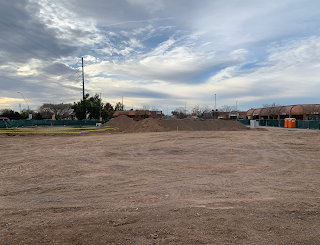When Phoenix was a city of orange groves
If you've lived in Phoenix for a while, you remember the orange groves. In fact, there are still orange groves around, and there may be a building that just went up recently that just replaced an orange grove near you. It's been going on for a long time.
Although nowadays it's become popular as a place to live, originally the Phoenix area, called the Salt River Valley, was all about agriculture. The idea was to transform the desert from worthless desert land to land where things could be grown. And it was very successful - the Salt River Valley has very fertile land, similar to the Crescent of the Nile River in Egypt, created over a millennia of flooding. What needed to happen was to control the flooding, and channel the water, which started for the Phoenix pioneers in the 1860s and was pretty much perfected by the building of the Roosevelt Dam on the Salt River in 1911.
At that time, oranges in the United States were very expensive. Nowadays, of course, you can wander into any grocery store and get all of the oranges you want for cheap, but not so back when the Roosevelt Dam was new. People love oranges, and citrus, and they can only be grown in warm climates, and can be very expensive to ship from foreign countries. So growing oranges, and all types of citrus, in the USA was a very important project. You could call it the Salt River Project if you want to. And it was very successful. The Salt River Valley started producing citrus in abundance. By the way, Californians started doing the same thing very successfully at the same time over in Southern California. So successfully, in fact, that they named an entire county near Los Angeles "Orange County". Really.
I'm too young to be impressed by oranges, but I remember that my grandmother, who grew up in Michigan, would tell me that at Christmas one of the most amazing gifts was an orange. Yes, a single orange. For a kid. They were wildly expensive, and the goal of farmers in the US was to grow them here, and get them into the market as quickly as possible. Growing citrus was practically a "gold rush".
So the Salt River Valley became covered with orange groves. With the warm winter temperatures, and reliable water from the Roosevelt Dam, it worked. And it made a fortune for Phoenix. Citrus became one of the five "Cs" of the Arizona economy (Copper, Cattle, Cotton, Citrus and Climate).
Like the Los Angeles area, the land became more valuable for housing than for agriculture, and little by little the orange groves went away. They've gone away so completely in Orange County that most people are surprised that there were any orange groves there at all before. Most of the orange groves went away in Phoenix starting after World War II, in the late 1940s and early 1950s, and as the valley grew, and new houses were built, the orange groves disappeared.
So if you're looking at old photos of Phoenix, and see row after row of a particular tree, chances are very good that you're looking at an orange grove. Or grapefruit, or any type of citrus.
Image at the top of this post: Flying over orange groves near Sunnyslope in the 1950s, Phoenix, Arizona.
If you like pictures of old-time Phoenix, please become a member of History Adventuring on Patreon. I share a LOT of cool old photos there, copyright-free, with no advertising. If you like Phoenix history and would like to help support my efforts to preserve and share precious digital historic images, please consider becoming a patron. Thank you!
Become a Patron!




Comments
Post a Comment